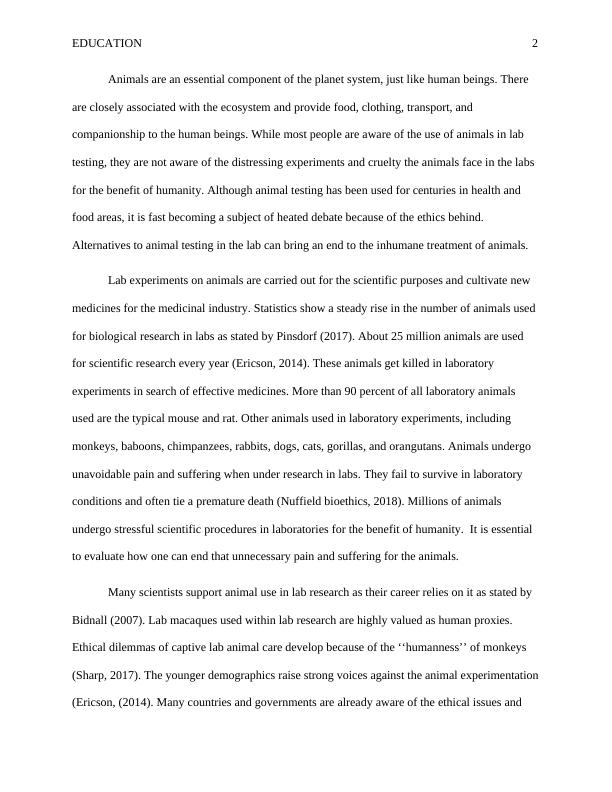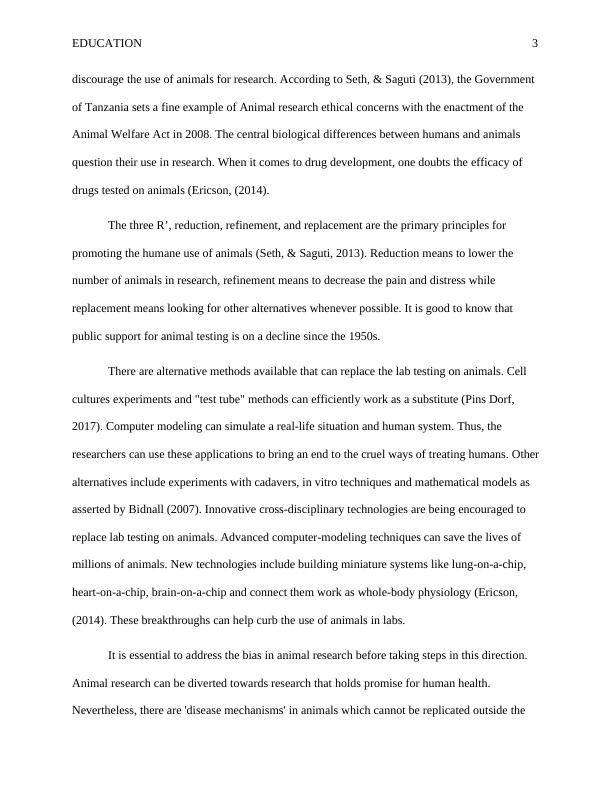Treating Animals Humanely: Alternatives to Inhumane Lab Testing
Added on 2023-06-07
6 Pages1156 Words305 Views
Running Head: ENGLISH 1
Treating Animals Humanely
Author's Name
Institutional Affiliation
Introduction
Treating Animals Humanely
Author's Name
Institutional Affiliation
Introduction

EDUCATION 2
Animals are an essential component of the planet system, just like human beings. There
are closely associated with the ecosystem and provide food, clothing, transport, and
companionship to the human beings. While most people are aware of the use of animals in lab
testing, they are not aware of the distressing experiments and cruelty the animals face in the labs
for the benefit of humanity. Although animal testing has been used for centuries in health and
food areas, it is fast becoming a subject of heated debate because of the ethics behind.
Alternatives to animal testing in the lab can bring an end to the inhumane treatment of animals.
Lab experiments on animals are carried out for the scientific purposes and cultivate new
medicines for the medicinal industry. Statistics show a steady rise in the number of animals used
for biological research in labs as stated by Pinsdorf (2017). About 25 million animals are used
for scientific research every year (Ericson, 2014). These animals get killed in laboratory
experiments in search of effective medicines. More than 90 percent of all laboratory animals
used are the typical mouse and rat. Other animals used in laboratory experiments, including
monkeys, baboons, chimpanzees, rabbits, dogs, cats, gorillas, and orangutans. Animals undergo
unavoidable pain and suffering when under research in labs. They fail to survive in laboratory
conditions and often tie a premature death (Nuffield bioethics, 2018). Millions of animals
undergo stressful scientific procedures in laboratories for the benefit of humanity. It is essential
to evaluate how one can end that unnecessary pain and suffering for the animals.
Many scientists support animal use in lab research as their career relies on it as stated by
Bidnall (2007). Lab macaques used within lab research are highly valued as human proxies.
Ethical dilemmas of captive lab animal care develop because of the ‘‘humanness’’ of monkeys
(Sharp, 2017). The younger demographics raise strong voices against the animal experimentation
(Ericson, (2014). Many countries and governments are already aware of the ethical issues and
Animals are an essential component of the planet system, just like human beings. There
are closely associated with the ecosystem and provide food, clothing, transport, and
companionship to the human beings. While most people are aware of the use of animals in lab
testing, they are not aware of the distressing experiments and cruelty the animals face in the labs
for the benefit of humanity. Although animal testing has been used for centuries in health and
food areas, it is fast becoming a subject of heated debate because of the ethics behind.
Alternatives to animal testing in the lab can bring an end to the inhumane treatment of animals.
Lab experiments on animals are carried out for the scientific purposes and cultivate new
medicines for the medicinal industry. Statistics show a steady rise in the number of animals used
for biological research in labs as stated by Pinsdorf (2017). About 25 million animals are used
for scientific research every year (Ericson, 2014). These animals get killed in laboratory
experiments in search of effective medicines. More than 90 percent of all laboratory animals
used are the typical mouse and rat. Other animals used in laboratory experiments, including
monkeys, baboons, chimpanzees, rabbits, dogs, cats, gorillas, and orangutans. Animals undergo
unavoidable pain and suffering when under research in labs. They fail to survive in laboratory
conditions and often tie a premature death (Nuffield bioethics, 2018). Millions of animals
undergo stressful scientific procedures in laboratories for the benefit of humanity. It is essential
to evaluate how one can end that unnecessary pain and suffering for the animals.
Many scientists support animal use in lab research as their career relies on it as stated by
Bidnall (2007). Lab macaques used within lab research are highly valued as human proxies.
Ethical dilemmas of captive lab animal care develop because of the ‘‘humanness’’ of monkeys
(Sharp, 2017). The younger demographics raise strong voices against the animal experimentation
(Ericson, (2014). Many countries and governments are already aware of the ethical issues and

EDUCATION 3
discourage the use of animals for research. According to Seth, & Saguti (2013), the Government
of Tanzania sets a fine example of Animal research ethical concerns with the enactment of the
Animal Welfare Act in 2008. The central biological differences between humans and animals
question their use in research. When it comes to drug development, one doubts the efficacy of
drugs tested on animals (Ericson, (2014).
The three R’, reduction, refinement, and replacement are the primary principles for
promoting the humane use of animals (Seth, & Saguti, 2013). Reduction means to lower the
number of animals in research, refinement means to decrease the pain and distress while
replacement means looking for other alternatives whenever possible. It is good to know that
public support for animal testing is on a decline since the 1950s.
There are alternative methods available that can replace the lab testing on animals. Cell
cultures experiments and "test tube" methods can efficiently work as a substitute (Pins Dorf,
2017). Computer modeling can simulate a real-life situation and human system. Thus, the
researchers can use these applications to bring an end to the cruel ways of treating humans. Other
alternatives include experiments with cadavers, in vitro techniques and mathematical models as
asserted by Bidnall (2007). Innovative cross-disciplinary technologies are being encouraged to
replace lab testing on animals. Advanced computer-modeling techniques can save the lives of
millions of animals. New technologies include building miniature systems like lung-on-a-chip,
heart-on-a-chip, brain-on-a-chip and connect them work as whole-body physiology (Ericson,
(2014). These breakthroughs can help curb the use of animals in labs.
It is essential to address the bias in animal research before taking steps in this direction.
Animal research can be diverted towards research that holds promise for human health.
Nevertheless, there are 'disease mechanisms' in animals which cannot be replicated outside the
discourage the use of animals for research. According to Seth, & Saguti (2013), the Government
of Tanzania sets a fine example of Animal research ethical concerns with the enactment of the
Animal Welfare Act in 2008. The central biological differences between humans and animals
question their use in research. When it comes to drug development, one doubts the efficacy of
drugs tested on animals (Ericson, (2014).
The three R’, reduction, refinement, and replacement are the primary principles for
promoting the humane use of animals (Seth, & Saguti, 2013). Reduction means to lower the
number of animals in research, refinement means to decrease the pain and distress while
replacement means looking for other alternatives whenever possible. It is good to know that
public support for animal testing is on a decline since the 1950s.
There are alternative methods available that can replace the lab testing on animals. Cell
cultures experiments and "test tube" methods can efficiently work as a substitute (Pins Dorf,
2017). Computer modeling can simulate a real-life situation and human system. Thus, the
researchers can use these applications to bring an end to the cruel ways of treating humans. Other
alternatives include experiments with cadavers, in vitro techniques and mathematical models as
asserted by Bidnall (2007). Innovative cross-disciplinary technologies are being encouraged to
replace lab testing on animals. Advanced computer-modeling techniques can save the lives of
millions of animals. New technologies include building miniature systems like lung-on-a-chip,
heart-on-a-chip, brain-on-a-chip and connect them work as whole-body physiology (Ericson,
(2014). These breakthroughs can help curb the use of animals in labs.
It is essential to address the bias in animal research before taking steps in this direction.
Animal research can be diverted towards research that holds promise for human health.
Nevertheless, there are 'disease mechanisms' in animals which cannot be replicated outside the

End of preview
Want to access all the pages? Upload your documents or become a member.
Related Documents
Use of Animals in Scientific Testinglg...
|4
|807
|379
Animal Experimentation in Psychological Researchlg...
|8
|1608
|49
Survey of Experimental Design and Reporting in Animal Researchlg...
|4
|619
|39
The Animal Law Questions 2022lg...
|12
|3146
|11
Animal Testing in Medical Research: Benefits, Drawbacks, and Alternativeslg...
|8
|2095
|370
CSR Responsibilities of Organizations in the UK and their Influence on the Community and Environmentlg...
|4
|1213
|319
